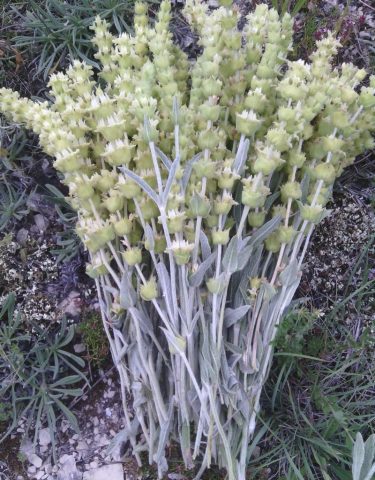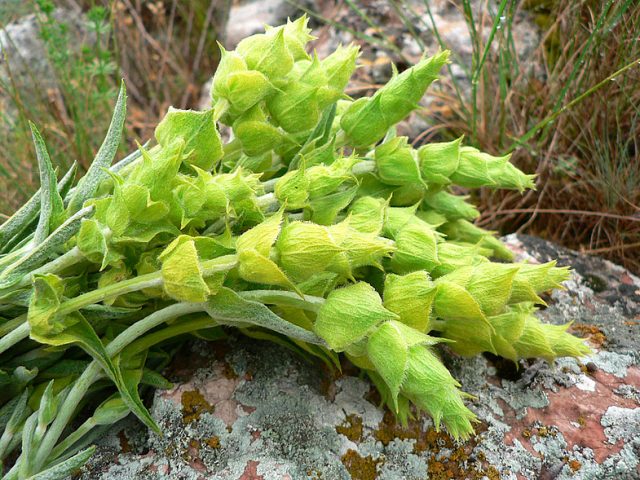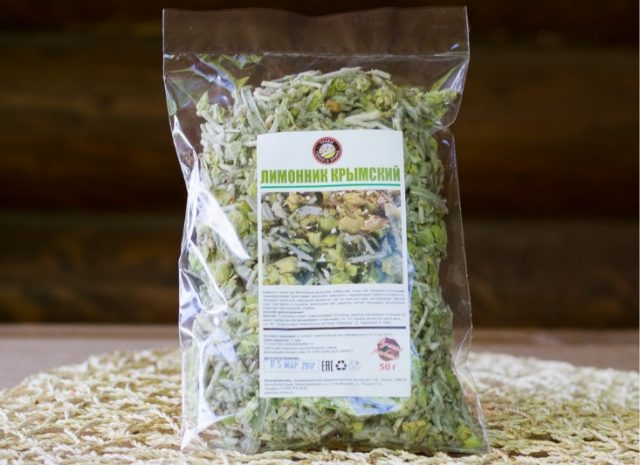Content
Lemongrass Crimean in a common name is Shepherd tea or Tatar tea. Grows on the Crimean peninsula. He is not found anywhere else, the exception is artificial cultivation at home.
Description of the herb Crimean lemongrass
The plant Lemongrass Krymsky is classified as a blue-flowered plant, it is perennial, has several flowering shoots, some of them are shortened. According to the photo, the plant Lemongrass Crimean is determined by the following signs: the stem is covered with hairs, a long inflorescence in the form of an ear, interrupted at the bottom.
The leaf plates are lanceolate, slightly elongated, obtuse. The flowers of the Crimean lemongrass have a pale yellowish color, collected in a corolla.
The bloom of the zheleznitsa begins in May-July in regions with a southern climate and from June-August in the middle lane.
Chemical composition
The leaves, flowers and stems of the Crimean magnolia vine contain essential oils in an amount of 0.003-0.006%, as well as iridoids, flavonoids. The seeds are 29-30% rich in fatty oils, the components of which are oleic, palmitic, stearic and linolenic acids.
Contained in the Crimean Schizandra and 10 amino acids, 23 minerals and trace elements. Iron, sodium, potassium and copper play an important role in the functioning of the human body.
Useful properties of Crimean lemongrass
In Crimea, the plant is considered a panacea for any ailment, it is used as a preventive measure against influenza.
For the purpose of treatment, you can use any part of the Crimean lemongrass, with the exception of the root system, therefore, the stems, and leaves, and inflorescences are harvested.
The healing properties of the Crimean Schizandra make it possible to use it as an anti-febrile remedy, a medicine for nausea and vomiting, and lung pathology.
In the form of lotions, the infusion is used for skin diseases, wounds, tumors and abrasions.
Vitamin C contained in Crimean Schizandra has the following effects on the body:
- Normalization of reduction and oxidation processes.
- Stimulation of the adrenal cortex.
- Increased capillary permeability.
- Strengthening the immune system.
Vitamin E is a prophylactic agent for thrombosis and promotes the resorption of the formed clots. It also has a beneficial effect on the reproductive system, reducing pain syndrome, facilitating the climacteric period. Decoctions from the Crimean lemongrass are used to treat wounds.
The minerals and salts present in the plant have a positive effect on the function of hematopoiesis and the state of the endocrine system. It is necessary to take into account their ability to regulate the acid-base balance in the body systems.
Lemongrass Crimean is used in the treatment of the following diseases:
- diabetes;
- whooping cough;
- hypothermia or overheating of the body;
- diseases of the eyes and hearing organs;
- diseases of the cardiovascular system;
- intestinal disorders (diarrhea, dysentery);
- genital diseases (gonorrhea, infertility, impotence);
- skin diseases (psoriasis, dermatoses and urticaria);
- fungal infections;
- baldness.
Rules for the procurement of raw materials
Crimean lemongrass brings not only benefits, but can cause harm if you use it illiterately or neglect the rules for processing raw materials.
You will not find an iron pot in pharmacies, the plant is not officially used on the pharmacological market, although its properties are being studied by specialists. The plant can be purchased through private entrepreneurs who sell goods on the Internet.
The highest quality raw materials are obtained by self-procurement. Lemongrass grows in the Crimea, so you can find the plant only there. The most likely place of its habitation is the Roman-Kosh mountain.
The best time for collection is during the summer months. For blanks, all aerial parts of the plant are used without damaging the root part. Freshly cut shoots and leaves are carefully laid out in the fresh air in the shade until completely dry.
At the end of the process, it is recommended that Crimean lemongrass be chopped or tied into bunches, placed in a dark place that can be periodically ventilated.
It is convenient to store Crimean lemongrass in canvas or fabric bags, the container must be labeled, where the date of manufacture and the name of the medicine are indicated.
Signs of violation of storage rules:
- the raw material changed color, smell;
- the presence of moisture or rot;
- the appearance of insects in bags with a plant.
The quality of the purchased raw materials from the Crimean magnolia vine is indicated by the integrity of the packaging and the compliance of the contents with the description.
Application methods
The most common recipe for using Crimean lemongrass is brewing tea. For this, young shoots and leaf plates, flowers are used.
Add 15 g of grass to 1 liter of boiling water and leave for 20 minutes. Closing and wrapping the container with a towel is not required. It is not recommended to use a thermos for brewing: the pleasant lemon aroma may be lost.
Lemongrass Krymsky is also used in cooking: it is added to dishes with fish and vegetables (it gives a pleasant aroma and specific taste).
It is possible to use the grass as an ornamental plant; with the help of lemongrass, "alpine meadows" are created. Nondescript flowers delight with a pleasant aroma throughout the summer and favorably emphasize other cultures.
If you do not want to take a drink from Crimean lemongrass, it is possible to add several sheets to regular tea. This will allow you to get the necessary beneficial properties and enjoy a pleasant aroma.
Common recipes for using lemongrass Crimean:
- Poultices. They are used for inflammation of the skin, including tumors and ulcers. For this, 2-3 tbsp. l. raw materials are poured into 200 ml of boiling water and left for 30 minutes. The present remedy is distributed over gauze, then the tissue is applied to the focus of inflammation for 2-3 hours. At the end of the procedure, wash off the solution with water. Lotions have analgesic and anti-inflammatory effects, reduce tissue swelling.
- With vomiting and nausea during pregnancy, it is necessary to brew a glass of boiling water 3 tbsp. l. raw materials and leave for an hour in a warm place. After the time has elapsed, the infusion is filtered, taken in 100 ml twice a day.
- With pathologies of the lungs 1 tbsp. l. raw materials are poured into 200 ml of boiling water and left to infuse for 30 minutes. After the medicine is filtered, take 100 ml 2-3 times a day.
- Perhaps treatment with lemongrass Crimean and impotence. The plant is crushed to a powdery state and mixed with alcohol in proportions of 1: 3. The tincture must be stored for 14 days in a closed cabinet, then strain and consume 1 tsp. in the morning.
- Bath with lemongrass Crimean has a restorative, relaxing and anti-inflammatory effect. For its preparation, 3 tbsp is dissolved in 2 liters of water. l. raw and simmer for 5 minutes. After the broth has cooled, it is filtered and added to the bath water. The duration of the procedure is 15 minutes. The course of treatment is 7-10 baths.
The effectiveness of therapy confirms the positive result - an improvement in well-being and the disappearance of symptoms of the disease.
The exception is alcohol tinctures. Useful properties are preserved in them for up to a year.
Contraindications to lemongrass Crimean
Despite the beneficial properties of herb lemongrass Crimean, there are a number of contraindications in which the use of the herb is impractical and dangerous.
It is recommended to refuse herbal treatment for people suffering from arterial hypertension and nervous overexcitation. The patient's condition will worsen if an individual plant intolerance is revealed.
At the beginning of the course of treatment, it is necessary to monitor the general condition for the appearance of a rash, fever, nausea and vomiting. These signs require immediate medical attention.
Conclusion
Lemongrass Crimean is a unique plant that includes a huge number of useful components. The correct collection of raw materials and their competent use are the guarantor of successful treatment and preservation of longevity.











